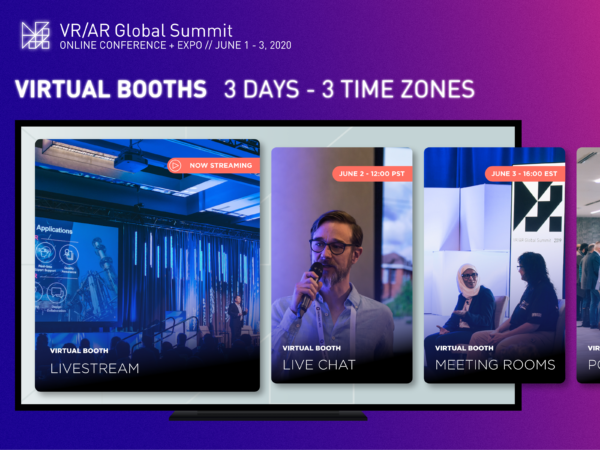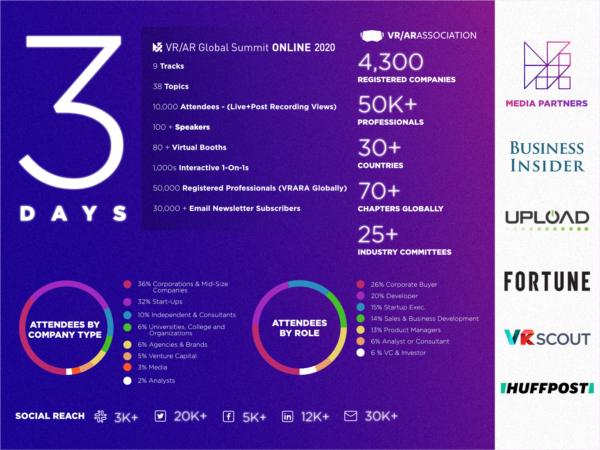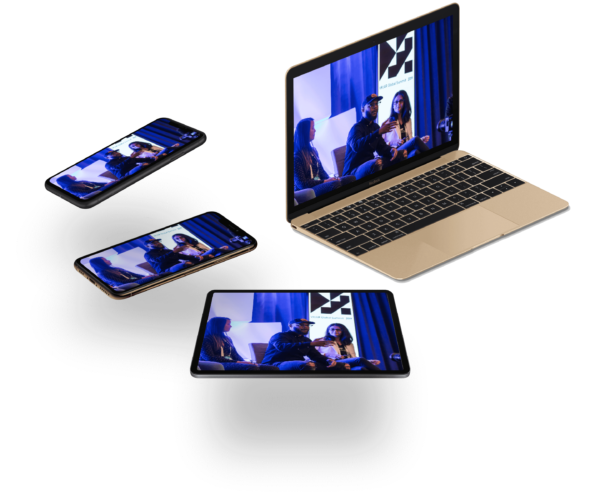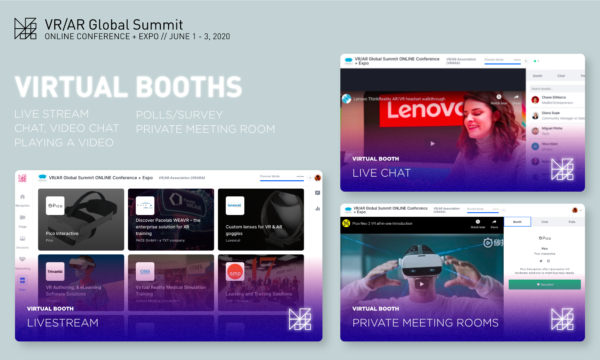by Dot Cannon
VR with new everyday uses. AR adding elements of fun and salesmanship to retail. An inspiring holographic work, presented to a healing city.
All of the above were highlights of Monday’s Day One of the VR/AR Global Summit and Expo Online.
For the first time, the VRARA presented their popular conference in an all-virtual format. As Executive Producer Anne-Marie Enns explained, in our earlier interview, the original plan for 2020 had been to host the conference in Portugal.
But the pandemic changed plans rapidly–and the conference is currently breaking new ground, as an all-virtual event.
Attendees received free access. Programming covered three time zones, with more than 200 speakers and exhibitors scheduled for the three-day event. (Presentations continue through Wednesday, June 3.)
More than thirty countries are represented, as participants in the VR/AR Global Summit and Expo. Virtual booths, networking and special events are all part of the program. Sessions are multiplatform, with a YouTube channel and recorded videos following the presentations.
And despite Monday’s early start (the Lenovo keynote speech began at 3:15 am, Pacific time, due to the conference being scheduled in UTC), the content was top-notch.
No single post could do justice to the program, nor to the staff who delivered it despite struggles with unfamiliar technology. (Admittedly, technical “hiccups” occurred, as everyone was getting used to the new presentation model!). But here are just a few highlights from Day One.
VR in new contexts

(Graphic courtesy of VR/AR Global Summit Online)
“Our product goal was to make people know VR, and experience VR as much as possible,” KT VR/AR/MR Business Manager Joonmo Park explained, during his presentation, “Redefining Experience with XR: An Enterprise Journey to Virtual Reality with Korea Telecom.”
Joonmo said Korea Telecom had been introducing VR applications in industries including healthcare, education and medicine.
A medical application, he said, was physical therapy. Joonmo displayed a slide of a patient “playing” a shooter game while wearing a VR headset, as he explained that the man was unwittingly following doctor’s orders.
“He’s moving a shooter without realizing that he’s exercising. (Once patients use this application at home, they can get better.)”
In addition, Joonmo said KT had introduced virtual reality in the travel industry, as well as the educational field. In November 2019, he continued, Korea Telecom launched its pilot program for an express-bus company. Virtual reality served to train drivers in new procedures–and to entertain passengers.
“Before, it (was) so boring to ride on the bus. (Now passengers can play games and watch movies in 360),” he said.
In Korea, Joonmo explained, VR in the educational field is mainly used for studying languages. An avatar can analyze the student’s pronunciation.
“And this changes the teacher’s role, in Korea.”
360 degrees of inspiration

(Image courtesy of VR/AR Global Summit Online, and used with permission.)
During his presentation, “Technology as a Character”, Satore Studio Founder and Creative Director Tupac Martir took his audience on a creative journey.
“In 2017, as I was about to jump on a flight to Milan, I received a call that Mexico had one of the biggest earthquakes in history,” he said.
Tupac, who grew up in Mexico, said he was both devastated and terrified for the city he loves. He knew he had to use his gifts to inspire everyone as Mexico City recovered.
The result: his seven-and-a-half minute installation, “Caminante (HIK+)”, projected on Torre Reforma, Mexico City’s tallest skyscraper.
“We wanted to (celebrate) the achievements of the Mexican people,” Tupac said. “…I wanted to give (them) the opportunity to celebrate their own achievements.”
Accordingly, he asked for submissions from social media.
“It actually became a very nice thing. We had over a million people (tweeting their achievements to be a part of the installation),” Tupac said.
Tupac and his teams from all over the world created a holographic character who moved through the piece.
“Our character kept evolving, so we had five different skins for him,” he said. “We had teams working in Australia, Japan, Thailand, Mexico, the U.S., Italy, Germany…”
Upon its release, “Caminante” provided inspiration and interest as the city healed.
“We had people in their cars, watching,” Tupac said. “It was a piece that brought an entire city together.”
Tupac’s next project, “Cosmos Within Us”, is a VR performance that “tries to break the concept of, what is an audience?”
When the pandemic subsides, Tupac said, he will be taking “Cosmos Within Us” on tour. The work centers on a 60-year-old man with Alzheimer’s disease. As the protagonist tries to hold on to his memories, the piece explores what is, and is not, his reality.
“Can I actually embed myself into your memories, and make your memories something even though they are not yours?” Tupac asked.
“Cosmos Within Us” will have interactive elements, with the audience and Tupac as director.
“We’re trying to break the boundary (between) what was physical, and what was in the headset.”
Engaging through AR

(Image courtesy of VR/AR Global Summit Online, and used with permission.)
“Retail sector, let’s get phygital!” exhorted 8th Wall VP of Product Tom Emrich during his presentation, “How Augmented Reality Experiences Will Save Retail”.
“Phygital”, he explained, equals “physical plus digital”.
And some ways of “getting phygital” with augmented reality, he said, included having customers “try on” products virtually, AR portals and interactive play.
“AR can bring the store to you,” he explained. “It places a portal in the user’s space.”
Or, in-store, augmented reality could transport the prospective customer to another location.
“Here, when the user walks toward the model, they are transported to the beach, (where) they learn more about the product.”
“AR can turn products into salespeople,” Tom said. “(This) creates a viral opportunity to snap and share what’s going on.”
Virtually “trying on” items, and virtual demos of makeup, could make the consumer feel that they already are familiar with a product, he continued.
In addition, augmented reality could assist customers with product assembly–as well as showing them the contents of a package.
And augmented reality presents opportunities for engaging a customer in a playful way.
“AR can turn packaging into interactive games, like the back of a cereal box,” Tom explained.
AR, he said, could also activate empty spaces–and provide for playful in-store experiences.
Tom referenced a “scavenger hunt” which Lego had done, where users go around the store and capture a series of “ghosts”.
“AR dramatically increases conversion (from viewer to customer),” he said. “It transforms stores into experiential destinations and turns products into salespeople.”

(Image courtesy of VR/AR Global Summit Online,, and used with permission.)
